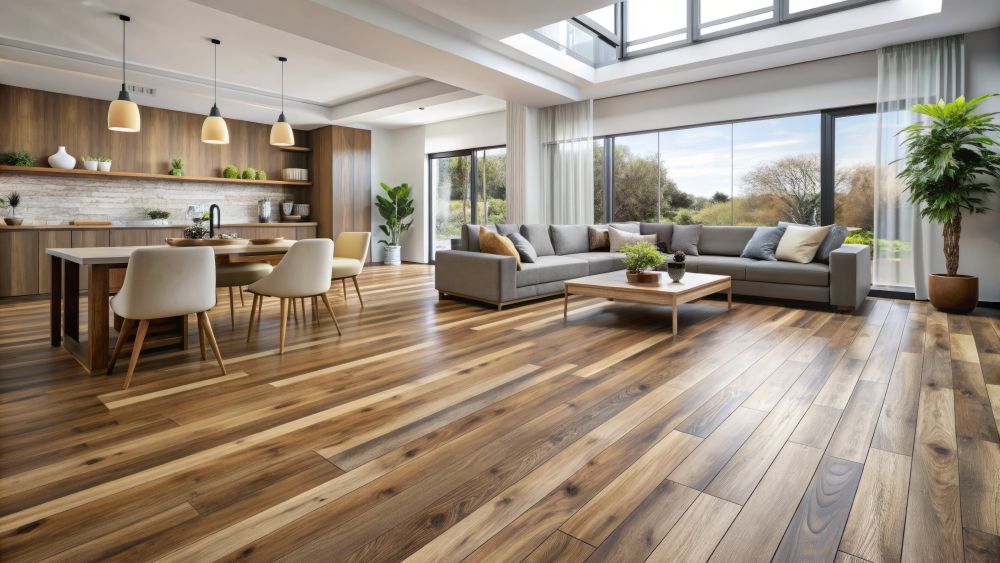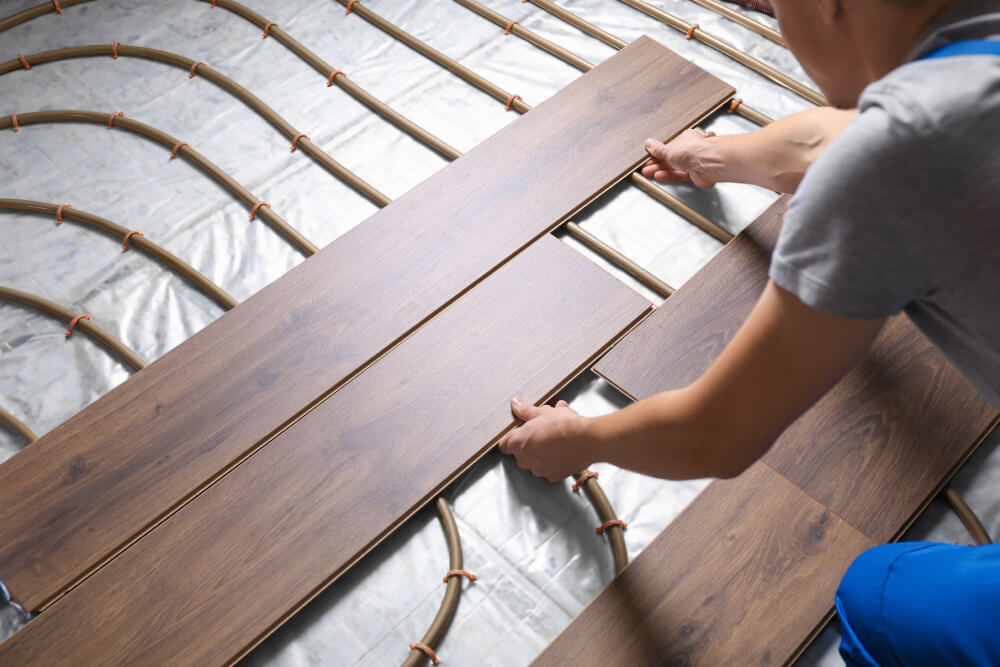1. Understanding Eco-Friendly Flooring
Overview: Eco-friendly flooring options are made from sustainable, renewable, or recycled materials. These flooring choices minimize environmental impact during production, use, and disposal. They often have lower VOC (volatile organic compound) emissions, contributing to better indoor air quality.
- Benefits:
- Sustainability: Made from renewable or recycled resources, reducing environmental impact.
- Healthier Indoor Air Quality: Low VOC emissions and natural materials contribute to a healthier living environment.
- Durability: Many eco-friendly flooring options are highly durable and long-lasting.
- Aesthetic Appeal: Available in a variety of styles and finishes to suit different interior design preferences.
2. Bamboo Flooring
Overview: Bamboo is a rapidly renewable resource, making it an excellent eco-friendly flooring option. Bamboo flooring is made from the stalks of the bamboo plant, which can grow up to 3 feet per day and reaches maturity in 5-7 years.
- Benefits:
- Renewable Resource: Bamboo is highly renewable, regenerating quickly after harvesting.
- Durability: Bamboo flooring is durable and resistant to wear and tear. Strand-woven bamboo is particularly strong and suitable for high-traffic areas.
- Aesthetic Appeal: Bamboo flooring offers a unique, contemporary look with natural variations in color and grain patterns.
- Low VOC Emissions: High-quality bamboo flooring has low VOC emissions, contributing to better indoor air quality.
- Drawbacks:
- Moisture Sensitivity: Bamboo can be sensitive to moisture and humidity, making it less suitable for bathrooms or basements.
- Quality Variation: The quality of bamboo flooring can vary significantly between manufacturers. It’s important to choose products from reputable sources.
- Best Applications:
- Living Rooms: Provides a stylish and durable surface for high-traffic areas.
- Bedrooms: Adds a warm, natural feel to sleeping spaces.
- Offices: Ideal for home offices due to its durability and modern appearance.
3. Cork Flooring
Overview: Cork flooring is made from the bark of the cork oak tree, which regenerates after harvesting. This sustainable material is soft, comfortable underfoot, and has natural insulating properties.
- Benefits:
- Renewable Resource: Cork is harvested from the bark of cork oak trees, which regenerate after harvesting, making it a sustainable choice.
- Comfort and Insulation: Cork flooring is soft and comfortable underfoot, providing natural thermal and acoustic insulation.
- Hypoallergenic: Cork is naturally resistant to mold, mildew, and pests, making it a hypoallergenic option.
- Aesthetic Appeal: Available in a variety of colors and patterns, cork flooring can complement various interior styles.
- Drawbacks:
- Moisture Sensitivity: Cork can be damaged by excessive moisture, so it’s not ideal for bathrooms or basements.
- Durability: While cork is durable, it can be susceptible to dents and scratches from heavy furniture or sharp objects.
- Best Applications:
- Living Rooms: Offers a comfortable and stylish surface for family areas.
- Bedrooms: Provides a warm and cozy feel underfoot.
- Home Offices: Reduces noise and adds comfort, making it perfect for workspaces.
Join HICP Homeowner’s Alliance
Connect with experts, get special discounts and enjoy member benefits
4. Reclaimed Wood Flooring
Overview: Reclaimed wood flooring is made from salvaged wood sourced from old buildings, barns, and other structures. This sustainable option repurposes existing materials, reducing the demand for new wood.
- Benefits:
- Sustainability: Reclaimed wood repurposes existing materials, reducing the need for new resources and preventing old wood from ending up in landfills.
- Unique Character: Each plank of reclaimed wood has unique characteristics, including natural weathering, knots, and grain patterns.
- Durability: Reclaimed wood is often more durable than new wood, having already been seasoned and aged.
- Low VOC Emissions: Typically has lower VOC emissions compared to some new wood products.
- Drawbacks:
- Cost: Reclaimed wood can be more expensive due to the labor-intensive process of sourcing, cleaning, and preparing the wood.
- Availability: The availability of reclaimed wood can be limited, and specific types or sizes may be difficult to find.
- Best Applications:
- Living Rooms: Adds character and a rustic feel to communal spaces.
- Bedrooms: Creates a warm and inviting atmosphere.
- Dining Rooms: Enhances the aesthetic appeal with its unique history and character.
5. Linoleum Flooring
Overview: Linoleum is made from natural materials, including linseed oil, wood flour, cork dust, and natural pigments. It is a durable and biodegradable flooring option that has been used for over a century.
- Benefits:
- Natural Materials: Made from renewable and biodegradable materials, linoleum is an eco-friendly choice.
- Durability: Linoleum is highly durable and can last for decades with proper care.
- Antimicrobial Properties: Naturally resistant to bacteria and fungi, making it a hygienic option.
- Aesthetic Variety: Available in a wide range of colors and patterns, linoleum can suit various design preferences.
- Drawbacks:
- Installation: Linoleum can be more challenging to install compared to other flooring options and may require professional installation.
- Maintenance: Requires regular sealing to maintain its appearance and protect against moisture.
- Best Applications:
- Kitchens: Durable and easy to clean, ideal for high-traffic areas.
- Hallways: Provides a resilient surface for areas with heavy foot traffic.
- Playrooms: Soft and comfortable underfoot, making it safe for children.
6. Recycled Carpet
Overview: Recycled carpet is made from recycled materials, such as plastic bottles and old carpet fibers. This sustainable option reduces waste and provides a soft, comfortable flooring solution.
- Benefits:
- Sustainability: Made from recycled materials, reducing waste and the demand for new resources.
- Comfort: Provides a soft and comfortable surface underfoot.
- Insulation: Offers excellent thermal and acoustic insulation.
- Variety: Available in a wide range of colors, patterns, and textures.
- Drawbacks:
- Durability: May not be as durable as other flooring options, especially in high-traffic areas.
- Maintenance: Requires regular vacuuming and occasional professional cleaning to maintain its appearance.
- Best Applications:
- Bedrooms: Provides a cozy and comfortable surface for sleeping areas.
- Living Rooms: Adds warmth and comfort to communal spaces.
- Home Offices: Reduces noise and adds a soft touch underfoot.
7. Concrete Flooring
Overview: Concrete flooring is made from a mixture of cement, water, and aggregates. When properly finished and sealed, it can be an eco-friendly and durable flooring option with a modern, industrial look.
- Benefits:
- Sustainability: Concrete can be a sustainable option when sourced locally and made with eco-friendly materials.
- Durability: Extremely durable and long-lasting, ideal for high-traffic areas.
- Energy Efficiency: Concrete has excellent thermal mass properties, helping to regulate indoor temperatures and reduce energy costs.
- Versatility: Can be stained, polished, or colored to achieve various looks and finishes.
- Drawbacks:
- Hardness: Concrete is hard underfoot, which can be uncomfortable for long periods and may lead to fatigue.
- Coldness: Concrete can be cold, especially in winter, though radiant heating can mitigate this issue.
- Cracking: Susceptible to cracking over time, though this can be minimized with proper installation and maintenance.
- Best Applications:
- Basements: Durable and moisture-resistant, making it suitable for below-grade installations.
- Garages: Provides a tough and resilient surface for heavy use.
- Modern Living Spaces: Achieves a sleek, industrial look for contemporary interiors.
8. Wool Carpet
Overview: Wool carpet is made from natural wool fibers, offering a luxurious and eco-friendly flooring option. Wool is a renewable resource, and wool carpets are biodegradable and recyclable.
- Benefits:
- Natural Material: Made from renewable and biodegradable wool fibers.
- Comfort: Soft and comfortable underfoot, providing warmth and insulation.
- Durability: Wool is naturally resilient and can withstand heavy foot traffic.
- Air Quality: Wool carpets have low VOC emissions and can help improve indoor air quality.
- Drawbacks:
- Cost: Wool carpet is typically more expensive than synthetic options.
- Maintenance: Requires regular vacuuming and professional cleaning to maintain its appearance.
- Moisture Sensitivity: Wool can be sensitive to moisture and stains, requiring prompt cleaning of spills.
- Best Applications:
- Bedrooms: Provides a warm and luxurious feel underfoot.
- Living Rooms: Adds comfort and elegance to communal spaces.
- Home Offices: Reduces noise and adds a touch of luxury.
9. Recycled Rubber Flooring
Overview: Recycled rubber flooring is made from recycled rubber materials, such as old tires. This eco-friendly option is durable, resilient, and suitable for various indoor and outdoor applications.
- Benefits:
- Sustainability: Made from recycled materials, reducing waste and the demand for new resources.
- Durability: Highly durable and resistant to wear and tear.
- Safety: Provides a non-slip surface, making it safe for use in high-traffic areas.
- Comfort: Soft and comfortable underfoot, reducing fatigue.
- Drawbacks:
- Aesthetic Appeal: May not have the same aesthetic appeal as other flooring options, though it is available in various colors and patterns.
- Odor: Can have an initial rubber odor, though this typically dissipates over time.
- Best Applications:
- Home Gyms: Provides a resilient and non-slip surface for exercise and fitness areas.
- Playrooms: Soft and safe for children’s play areas.
- Basements: Durable and moisture-resistant, suitable for below-grade installations.
Choosing eco-friendly flooring options for your home not only reduces environmental impact but also promotes healthier indoor air quality and supports sustainable resource use. With a variety of materials available, from bamboo and cork to reclaimed wood and recycled carpet, homeowners can find sustainable flooring that meets their aesthetic preferences and functional needs. By considering the benefits and drawbacks of each option, you can make an informed decision that enhances the beauty, comfort, and sustainability of your living space. Embracing eco-friendly flooring choices is a significant step toward creating a more sustainable and environmentally responsible home.








